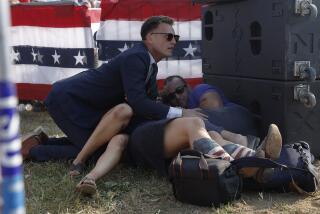Police Up in Arms on Growing Use of Toy Guns : ‘Look-Alikes’ Can Pass for Real Thing, Sometimes With Tragic Consequences
For the lifeguards at Huntington Beach State Park, the radio report on July 27 was more disturbing than if tall fins had been spotted churning through the surf. A frightened family had rushed to lifeguard tower No. 12, saying that an oddly dressed man was roving the beach with an assault rifle.
The lifeguards, who double as armed peace officers, anxiously picked their way through the thick mat of sunbathers, finally spotting the suspect: a 21-year-old man in full camouflage and combat gear, accompanied by what appeared to be an armed woman.
Lifeguard supervisor Kenneth Kramer said he and three fellow officers followed the suspects to a restroom, then moved in, shouting: “Drop your weapons!” The suspects complied. After frisking them, the lifeguards examined their rifles--plastic “look-alike” squirt guns. The couple, who were not charged, were participants in a new pastime in which beach-goers wage water gun battles on the sand.
Mall Incident
Last Sunday, in a parking lot outside the Laguna Hills Mall, another scene unfolded. A 21-year-old man pointed what appeared to be a handgun at two CHP officers responding to reports of a gun-toting man behaving erratically and threatening passers-by. After repeatedly warning the man to drop his gun, one CHP officer opened fire, seriously wounding the man in the chest and arm. Officers later discovered that the gun was a Crossman pellet gun, a replica of a government-issue Colt .45 that sells at sporting goods stores for about $50.
These types of incidents have law-enforcement agencies throughout California up in arms over the increasing use of look-alike guns--weapons that include a wide range of inexpensive toys, replica air and pellet guns, and non-firing replica or “counterfeit” guns specifically marketed for gun collectors.
Last month, the Anaheim City Council unanimously passed an ordinance outlawing the threatening use of fake guns. The Los Angeles County Sheriff’s Department will propose legislation concerning the guns this fall, and the peace officers who patrol the state’s parks and beaches are determined to ban look-alike guns from their turf altogether.
Squirt guns have been a fad on beaches for the past couple of summers, Kramer said. The latest versions duplicate everything from .357 magnums to Israeli Uzi automatics, and lifeguards have filled boxes with toy guns confiscated in confrontations.
Last summer, for instance, a young aide at an entrance station locked herself in a bathroom after frantically reporting that a man waiting to enter the park had threatened another motorist with a handgun. Twelve officers responded and “drew down” on the suspects, pulling them from their car and handcuffing them. The weapon was a look-alike cap gun, Kramer said.
On the same day as the Laguna Hills Mall incident, state lifeguards questioned a man with a look-alike Mac 10 automatic pistol, and Huntington Beach police later pulled over a car after seeing one of the occupants brandishing a fake pistol, Kramer added.
“I’m a certified firearms instructor, and I’ve been trained in identifying firearms,” Kramer said. “But up close or from a distance, they look identical to real weapons.”
“I don’t think there’s an officer who can’t tell you a story (about confronting a suspect who wielded a look-alike weapon),” said Officer Ken Daily, a spokesman for the California Highway Patrol’s San Juan Capistrano office.
A few years ago, Daily and his partner chased down a drunk driver on Interstate 5. “As I was approaching the driver’s side, he suddenly reached into the back seat. I glanced in and saw him reaching for an M-1 carbine. . . . As it turned out, it was a “ ‘Spittin’ Image’ BB gun,” Daily said. “He said he suddenly remembered it and didn’t want me to think it was the real thing.”
If Daily hadn’t been able to jerk open the rear door and grab the gun, which the man appeared to be aiming, “I probably would have had to shoot,” Daily said.
On another occasion, a passenger in a stopped car that Daily was approaching jumped out clutching what looked like an automatic pistol. “I immediately drew down on him. . . . It was a little squirt gun. Looked just like the real thing. He said he’d forgotten he had it in his hand. Ten feet away from someone, especially when it’s dark, you can’t wait till he fires to decide if it’s a real gun or not--then it’s too late for you.”
‘Worst-Case Scenario’
Jack Roggenbuck, chief of visitor services for the state Department of Parks and Recreation, warns that officers must assume “a worst-case scenario” when they approach a seemingly armed suspect, and that they are trained to shoot the moment a suspect appears to be aiming a gun. But Roggenbuck worries that as police encounter more and more toy guns, there’s a danger that they will begin to “drop their guard.”
Either way, tragedy can result. In the widely publicized 1983 case, a Stanton police officer entering a darkened room shot and killed 5-year-old Patrick Mason, only later realizing that the gun the boy clutched was a toy.
“The danger is very, very great,” said Police Lt. Dan Cooke, public information officer for the Los Angeles Police Department. “People are on edge these days and you can’t blame them. . . . You can visualize all kinds of scenarios that end tragically.”
Cooke, who concedes that he recently had the plastic “Dragnet” squirt gun he uses in his safety speeches confiscated by Los Angeles Airport security, reflected the views of many colleagues in saying that he isn’t opposed to kids playing with toy guns.
“Replica guns aren’t new; what is new is people running around the streets with them,” Cooke said. “Heck, I used to have a Tom Mix cap gun when I was a kid. There’s a sort of love affair with guns in this country, and kids grow up with them. Of course there’s quite a difference between the cap guns of then, and the Uzi replicas today. There are guns that are so close I won’t let my kids have them.”
“I don’t know of a society in which children do not play with weapons,” said Garry Chick, a professor at the University of Illinois and member of the Assn. for the Anthropological Study of Play.
“Children’s play obviously involves a great deal of fantasy . . . ,” Chick said. Emphasizing that his views are “just a hunch,” he added, “These extremely realistic toys may detract from the fantasizing about the object itself and may in fact contribute to the fantasy of the situation. . . . I think there’s a real difference between using a stick as a gun and a miniature (look-alike) Uzi.”
While a child with a stick gun can drift from a Rambo fantasy to a cowboy fantasy to a Civil War fantasy, a child with a toy Uzi is likely to find himself embroiled exclusively in very realistic modern wars, he said. “Obviously, if you do it in public there’s a difference if the cops see you. But I think there’s a difference in the fantasy, too.”
Seen as Increasing Danger
Anaheim enacted a fake-gun ordinance in response to what was seen as an increasing danger, said Assistant City Atty. Mark A. Logan. “We’ve had plenty of cases where someone will be involved in a dispute involving traffic right of way. The next thing you know, somebody’s pointing what looks like a real gun out the window.” As a result, cars go screeching across two or three lanes creating traffic hazards, and high-speed pursuits have occurred, he said.
Since the ordinance passed July 22, Logan has had calls from several other cities interested in enacting similar laws, he said.
Los Angeles County Sheriff Sherman Block hopes to propose even stronger fake-gun regulations at the state level this fall. “We are very, very concerned about these replica (and toy) guns.” People are committing more and more crimes with fake guns, Block said, “Yet a person having such a device in their possession is not guilty of any criminal offense.
“It’s my belief that any person found to have committed a crime with one of these replicas should be dealt with as if this were a real gun capable of injuring or killing a person,” he said.
Block also will propose that toy guns “be sold in bright, conspicuous colors so that anyone seeing them will know that they are toys and not real weapons.”
Safety Policy Cited
James Baker, spokesman for the National Rifle Assn. in Washington, said his group’s efforts are “limited to functioning firearms.” He added, however, that the NRA’s safety policy stresses that a gun should never be pointed “at anything that you don’t intend to shoot--be it a toy gun or a real gun.”
Daisy Manufacturing Co. in Rogers, Ark., makes look-alike BB and pellet guns, including an Uzi and a KG9 SP assault rifle in its “paramilitary line,” and 12 “soft air” guns such as a Colt .45 and Remington shotgun, which fire low-velocity plastic pellets.
“We make them primarily as collectors’ pieces,” said David Lewis, a company spokesman. He said Daisy supported the newly passed and proposed laws on look-alike weapons. “We would go along a hundred percent--anything regulating irresponsible use in public places.” He stopped short of supporting Sheriff Block’s color suggestion, however. “Obviously that would defeat the purpose of making a detailed replica.”
Saying that products such as the “Rambo M-24 Assault Rifle” and “Rambo 45’er Anti-Terrorist Rapid Fire Machine Gun” make up a very small segment of his company’s product line, Jerry Leighton, executive vice president at Arco Industries Ltd., was also unwilling to accept Block’s color proposal.
“We make an Uzi that goes rat-tat-tat. I couldn’t imagine it in a bright day-glo color,” he said. “I understand the point though--what would happen in a dark alley? But in a dark alley, a broom stick might look like a gun. A stapler might look like a gun.”
‘A Marketing Decision’
Asked why toy manufacturers are making their toys increasingly realistic, Leighton said, “To be honest it’s a marketing decision. Realistic-type guns have proven to sell better over the years than fairy-tale type guns.”
And toy guns do sell. According to the Toy Manufacturers of America, toy guns and rifles, including squirt guns but not BB or pellet guns, accounted for $68 million out of “a total industry shipment” of toys totaling more than $8.5 billion in 1985.
A brief survey of young shoppers browsing through the arsenal at Toys R Us in Costa Mesa suggested that the more realistic the gun, the more kids like it.
“When you’re playing, you want it to be as realistic as possible,” said one 17-year-old boy.
“People wouldn’t play with them if they weren’t realistic,” said his 13-year-old brother.
A moment later the three Miner brothers of Mission Viejo stormed into the toy gun aisle, vociferously proclaiming the “awesomeness” of the available assortment. They reserved their greatest accolades for the more realistic models.
What does a toy Luger or Uzi have over a squirt gun such as “Battling Bug”--a less than realistic replica of a common housefly, complete with red eyes and purple wings? “It gets you more into it, I guess,” said Paul, examining a Daisy “Defenders of Freedom” Max 12, which sells for about $15.
“And you can fake people sometimes,” added brother David, grinning the devilish grin of an innocent 8-year-old. “Like carry it around and make people think it’s real.”
More to Read
Sign up for Essential California
The most important California stories and recommendations in your inbox every morning.
You may occasionally receive promotional content from the Los Angeles Times.










